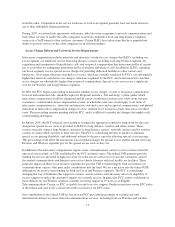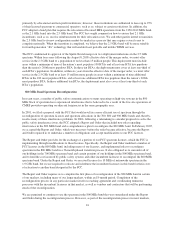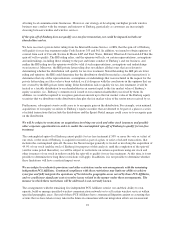Sprint - Nextel 2005 Annual Report Download - page 34
Download and view the complete annual report
Please find page 34 of the 2005 Sprint - Nextel annual report below. You can navigate through the pages in the report by either clicking on the pages listed below, or by using the keyword search tool below to find specific information within the annual report.with our obligations under our agreements with them, particularly with respect to the restrictions noted above.
Continued compliance with those restrictions may limit our ability to achieve synergies and fully integrate the
operations of Nextel and Nextel Partners, following its expected acquisition, in the areas served by those PCS
Affiliates. We could incur significant costs to resolve these issues.
Risks Related to our Business and Operations
We face intense competition that may reduce our market share and harm our financial performance.
Each of our three operating segments faces intense competition. Our ability to compete effectively depends on,
among other things, the factors discussed below.
The blurring of the traditional dividing lines between local, long distance, wireless, video and Internet
services contribute to increased competition.
The traditional dividing lines between long distance, local, wireless, cable and Internet services are increasingly
becoming blurred. Through mergers, joint ventures and various service expansion strategies, major providers are
striving to provide integrated services in many of the markets we serve. This trend is also reflected in changes in
the regulatory environment that have encouraged competition and the offering of integrated services.
We expect competition to intensify across all of our business segments as a result of the entrance of new
competitors or the expansion of services offered by existing competitors, and the rapid development of new
technologies, products, and services. We cannot predict which of many possible future technologies, products, or
services will be important to maintain our competitive position or what expenditures we will be required to make
in order to develop and provide these technologies, products or services. To the extent we do not keep pace with
technological advances or fail to timely respond to changes in the competitive environment affecting our
industry, we could lose market share or experience a decline in revenue, cash flows and net income. As a result
of the financial strength and benefits of scale enjoyed by some of our competitors, they may be able to offer
services at lower prices than we can, thereby adversely affecting our revenues, growth and profitability.
If we are not able to attract and retain customers, our financial performance could be impaired.
Our ability to compete successfully for new customers and to retain our existing customers will depend on:
• our marketing and sales and service delivery activities;
• our ability to anticipate and develop new or enhanced services that are attractive to existing or potential
customers; and
• our ability to anticipate and respond to various competitive factors affecting the industry, including new
services that may be introduced by our competitors, changes in consumer preferences, demographic
trends, economic conditions, and discount pricing and other strategies that may be implemented by our
competitors.
A key element in the economic success of communications carriers is the ability to retain customers as measured
by the rate of subscriber churn. Our ability to retain customers and reduce our rate of churn is affected by a
number of factors including, with respect to our wireless business, the actual or perceived quality and coverage
of our network and the attractiveness of our service offerings. Our ability to retain customers in our businesses
also is affected by competitive pricing pressures and the quality of our customer service. Our efforts to reduce
churn may not be successful. A high rate of churn could impair our ability to increase the revenues of, or cause a
deterioration in the operating margins of, our wireless operations or our operations as a whole.
As the wireless market matures, we must increasingly seek to attract customers from competitiors and face
increased credit risk from first time wireless subscribers.
We increasingly must attract a greater proportion of our new customers from our competitors’ existing customer
bases rather than from first time purchasers of wireless services. The higher market penetration also means that
23
























